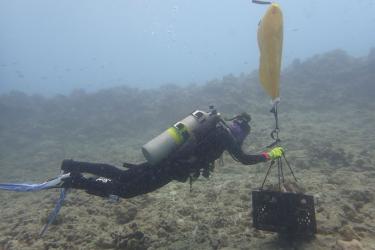NOAA researchers will spend 2 months this summer aboard the NOAA Ship Oscar Elton Sette in the waters surrounding the Mariana Archipelago. They will conduct the first comprehensive survey for cetaceans (whales and dolphins) and seabirds of Guam and the Commonwealth of the Northern Mariana Islands Exclusive Economic Zone. This survey is part of a 5-year partnership between NOAA Fisheries, U.S. Navy, and Bureau of Ocean Energy Management. The survey will extend from early May to mid-July, surveying along predetermined transect lines while we look and listen for cetaceans and seabirds.
Study Area
Guam and the Commonwealth of the Northern Mariana Islands make up the Mariana Archipelago, the westernmost location of the U.S. Pacific Islands region. Prominent underwater features include the seamounts of the West Mariana Ridge and the deep submarine canyon known as the Mariana Trench. The deepest location on Earth is found here—Challenger Deep, which is 7 miles below the surface. Such underwater features can affect the local oceanographic conditions, which may influence the distribution of fish and cetaceans.
The United States established the Marianas Trench Marine National Monument in 2009. It has three units:
- The Trench Unit
- The Islands Unit, which includes the underwater areas surrounding the three northernmost Mariana Islands: Farallon de Pajaros (also known as Uracus), Maug, and Asuncion
- The Volcanic Unit or Arc of Fire Refuge, which includes 21 underwater volcanic sites
Science Operations and Goals
There are three primary components to our survey:
- Visual observations for cetaceans (including photo-identification and biopsy sampling)
- Passive acoustic monitoring (towed hydrophone arrays and drifting acoustic recorders)
- Ecosystem assessments (visual surveys for seabirds and measurement of oceanographic variables)
We will also recover and redeploy two stationary acoustic recorders, called High Frequency Acoustic Recording Packages, located off Saipan and Pagan.
The survey will complement our ongoing efforts to conduct comprehensive marine mammal, seabird, and ecosystem surveys in U.S. waters in the Pacific every 3–6 years. These surveys estimate the abundance of protected species populations, develop spatial models of species distributions, and monitor their status and trends. They also support environmental planning processes for the Navy under the Marine Mammal Protection Act and the Endangered Species Act.
Cetacean Species in the Mariana Archipelago
The Pacific Islands Fisheries Science Center has previously seen or heard 20 known cetacean species within the Mariana Archipelago. During small-boat surveys in the southern islands (Guam to Saipan) from 2010 to 2019 and shipboard surveys in 2015 and 2018, 16 species of cetaceans were seen:
- Spinner dolphin
- Pantropical spotted dolphin
- Striped dolphin
- Bottlenose dolphin
- Rough-toothed dolphin
- Pygmy killer whale
- Short-finned pilot whale
- False killer whale
- Melon-headed whale
- Risso's dolphin
- Dwarf sperm whale
- Blainville's beaked whale
- Cuvier's beaked whale
- Sperm whale
- Humpback whale
- Bryde's whale
We also use passive acoustic monitoring to detect species. So far, we have heard (but not yet seen) 4 known and 1 unknown species of cetaceans:
- Blue whale
- Fin whale
- Minke whale
- Longman’s beaked whale
- An unknown species of beaked whale referred to as the “Cross Seamount beaked whale”




